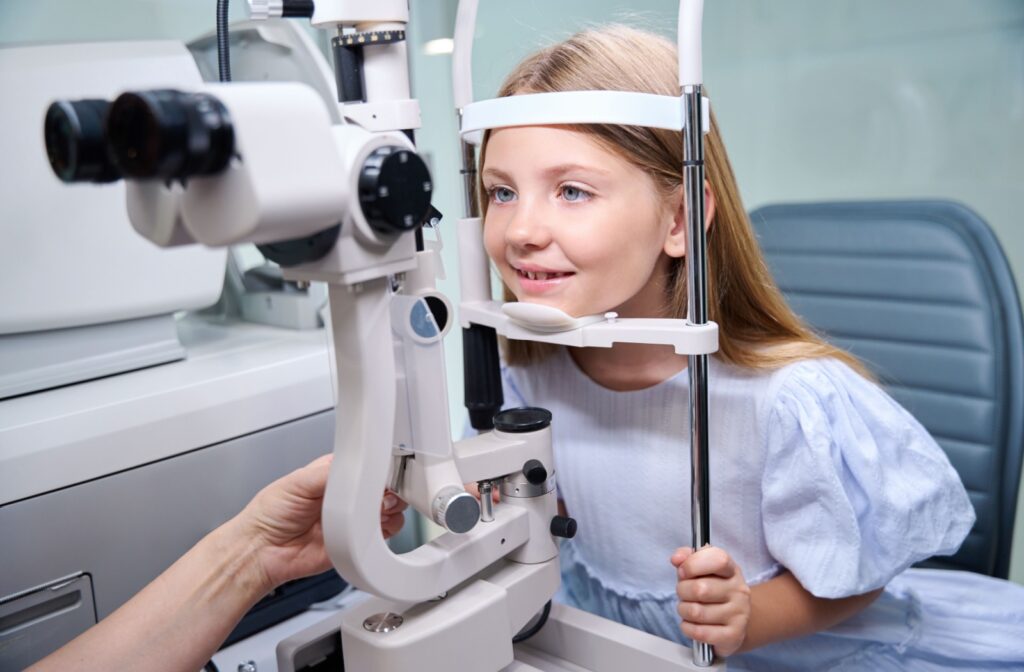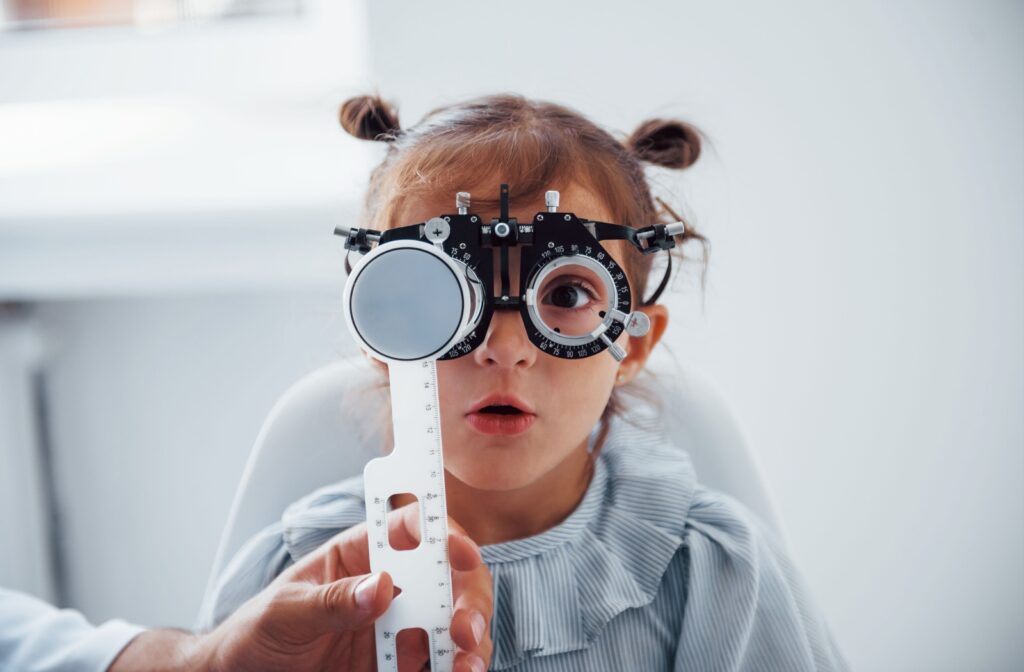As parents, we want to give our children every advantage in life, including the ability to see clearly and comfortably as they grow. But many vision problems in kids can go unnoticed until they begin to interfere with learning, behavior, or confidence. So, when should your child first visit the eye doctor?
Children should have their first comprehensive eye exam between 6 and 12 months of age, with regular follow-ups throughout childhood. We’ll walk you through when and why your child should see an eye doctor, what signs to watch for, and how early exams and myopia control programs can support lifelong vision health.
Why Are Early Children’s Eye Exams Important?
Good vision is crucial for early childhood development. Kids use their vision for everything—from learning to walk and recognize faces, to reading, writing, and playing. In fact, about 80% of what a child learns in school is presented visually. Undiagnosed vision issues can impact academic performance, attention span, and even emotional development.
Many common vision problems, such as nearsightedness (myopia), farsightedness, and astigmatism, begin in early childhood but may not be obvious without a proper eye exam. Children often can’t explain what they’re experiencing or may assume that everyone sees the world the way they do. That’s why proactive eye care is so important.
How Soon (& How Often) Should My Child Visit a Kid’s Eye Doctor?
The American Optometric Association recommends the following timeline for pediatric eye exams:
- First exam: Between 6 and 12 months of age
- Second exam: Between 3-5
- Third exam: Before starting first grade (around age 5 or 6)
- Ongoing exams: Every 1–2 years thereafter, unless otherwise advised by your eye doctor
These early visits help ensure that your child’s vision is developing properly and that any issues, like amblyopia (lazy eye), strabismus (eye turn), or refractive errors, are detected and treated early.
Children with existing vision problems or a family history of eye conditions may need to be seen more frequently. We can provide a personalized exam schedule based on their individual needs.
Warning Signs of Vision Problems in Children
Even if your child hasn’t yet had an eye exam, there may be signs that something isn’t quite right with their vision. Keep an eye out for the following symptoms:
- Squinting or tilting the head to see
- Sitting very close to the TV or holding books too close
- Frequent eye rubbing or blinking
- Difficulty concentrating or avoiding close-up work
- Complaints of headaches or tired eyes
- Trouble catching balls or navigating spaces
- Covering one eye or favoring one side when looking at things
- Falling behind in school or showing frustration during reading or writing
If you notice any of these behaviors, schedule an eye exam as soon as possible. The earlier a problem is caught, the easier it is to manage or correct.
The Importance of Myopia Control in Kids
One of the most common and fast-growing vision issues in children is myopia, or nearsightedness. Myopia causes distant objects to appear blurry, and it often begins in school-age children, then becomes worse during the teenage years.
The rise in digital screen use, increased time spent indoors, and reduced outdoor activity are all contributing to the increasing prevalence of myopia in kids today.
Why is this a concern? Left unmanaged, myopia can progress into high myopia, which is associated with a greater risk of serious eye conditions later in life, such as:
Thankfully, there are now proven myopia control treatments that can help slow or even stop the progression of nearsightedness in children. These may include:
- Glasses or contact lenses designed to control eye growth
- Atropine eye drops that help manage the development of myopia
- Lifestyle recommendations like increasing time outdoors and reducing near work
If your child has been diagnosed with myopia, or if it runs in your family, talk to your eye doctor about enrolling in a myopia control program early. Managing it now can make a big difference in your child’s long-term vision and eye health.

What to Expect During a Child’s Eye Exam
Children’s eye exams are safe, gentle, and tailored to their age and development. We’ll check more than just how well your child can read letters on a chart. A comprehensive exam typically includes:
- Testing visual acuity (clarity of vision at various distances)
- Evaluating eye alignment and tracking
- Checking depth perception and eye muscle coordination
- Assessing overall eye health and development
- Looking for signs of refractive errors or underlying conditions
Early exams often reveal small issues that can be easily corrected, which allows you to avoid more serious issues later on.
Support Your Child’s Success with Early Vision Care
Children rely on their vision to explore, learn, and engage with the world. By scheduling regular eye exams starting in infancy and continuing through their school years, you can help them avoid being held back by undetected vision problems.
If your child hasn’t had their first eye exam, or if it’s time for a check-in, Total Vision Little Tokyo in Los Angeles is here to help. Our friendly team offers comprehensive pediatric eye care, including advanced myopia control programs to support your child’s long-term vision health.
Contact us today to schedule an appointment and give your child the clear start they deserve.



